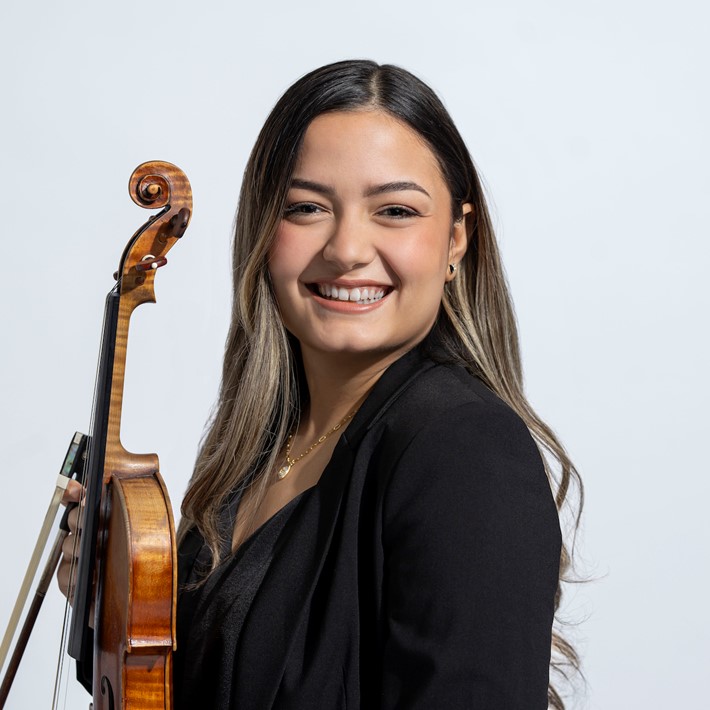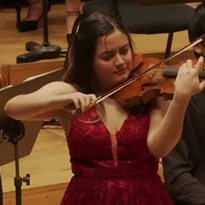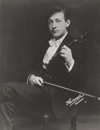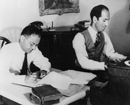People in the News
New Artist of the Month: Violinist Gabriela Lara
 CHICAGO—May there be more fairytale stories like Gabriela Lara’s in the brutal world of orchestra auditions.
CHICAGO—May there be more fairytale stories like Gabriela Lara’s in the brutal world of orchestra auditions.
In 2022, the Venezuela-born violinist became the inaugural recipient of the Chicago Symphony Orchestra Fellowship Program, which she won shortly after holding a similar fellowship with the Grant Park Music Festival. On Jan. 27, she’ll notch another “first,” officially becoming the CSO’s newest rostered member and its first hired by Music Director Designate Klaus Mäkelä.
Both the CSO Fellowship and the Civic Orchestra of Chicago, the CSO training orchestra—Lara was its concertmaster in 2023—are designed to help young musicians get a foothold in major orchestras. Neither, however, guarantees that those musicians will actually get hired by the CSO. The last Civic alumnus to join orchestra was violist Danny Lai, in 2014.
Lara is Mäkelä’s only hire so far. Other violin seats went unfilled in her audition round, and the search this fall for the orchestra’s four cello vacancies ended in no-hires. That Lara, 24, is the only musician to rise above such rigorous searches was “miraculous,” says CSO president Jeff Alexander.
“She wasn't treated differently than any other candidate. Klaus had never heard her [one-on-one]; he certainly didn't know her. He was listening with fresh ears. She won fair and square, which is something she can be really proud of,” Alexander says. “She was already a great violinist. But I’d like to think spending more than 20 weeks a year surrounded by really great violinists [as a CSO Fellow] made her that much more prepared to win an audition.”
Lara grew up in Quíbor—a suburb of Barquisimeto, Venezuela’s fourth-largest city, and about 250 miles from the capital, Caracas. Aside from some fond memories of her grandfather accompanying himself on the cuatro, her family wasn’t particularly musical. Nonetheless, when Lara was six, her mother took her to the local school to show her the El Sistema instruments. From that day on, the family lore goes, Lara asked for a violin “every day for, like, three months.” Her parents relented and bought her one for Christmas.
As is the norm in El Sistema, Lara’s progression through the program brought her to larger and larger urban centers—and more prestigious orchestras. She is an alumna of the Teresa Carreño Symphony Orchestra, El Sistema’s top orchestra, and has sat in with the Simón Bolívar Symphony Orchestra, joining it on a European tour that included a stop at the Berliner Philharmonie. She has also been a soloist with the Simón Bolívar orchestra, in Bruch’s Violin Concerto.
When it came time for Lara to go to conservatory, her violin teacher, Francisco Diaz, referred her to Almita Vamos, a respected pedagogue at Roosevelt University’s Chicago College of Performing Arts (CCPA). Many of El Sistema’s best and brightest violinists have since passed through Vamos’s studio, which also counts Benjamin Beilman, Rachel Barton Pine, and Jennifer Koh as alumni. CCPA was the only school Lara applied to; she got in with a full scholarship. She graduated with her Bachelor of Music in 2022 and Master in Music Pedagogy in 2024.
 “I've always admired that, when she gets up to play, she doesn't have to warm up. There's always that beautiful sound right away,” Vamos says. “I think sound is probably a good percentage of what gets somebody into an orchestra. They have to fit; they have to be able to blend; they have to be sensitive; they have to listen.”
“I've always admired that, when she gets up to play, she doesn't have to warm up. There's always that beautiful sound right away,” Vamos says. “I think sound is probably a good percentage of what gets somebody into an orchestra. They have to fit; they have to be able to blend; they have to be sensitive; they have to listen.”
Others have taken note of that beautiful sound. Since moving to the U.S., Lara won the 2021 Frank Preuss International Violin Competition and claimed second place in the 2021 Sphinx Solo Competition. As a CSO Fellow, she became a prolific part of the orchestra’s violin section, almost always spottable in the seconds, then firsts. She even joined the orchestra for its European tour last year, an experience she singled out as a highlight, along with visits by Jaap van Zweden (“It was like playing Beethoven Five for the first time”), violinist/conductor Nikolaj Szeps-Znaider (“Seeing him say his ideas and then play them was just amazing”), and, of course, Mäkelä. She played under him in Mahler’s Fifth Symphony in the 2022/23 season; Lara proudly notes that his forthcoming performance of the Mahler Third, in April, will make her a Mahler symphony completionist.
Lara opted not to pursue a third fellowship year at the CSO this season after landing a job in the Milwaukee Symphony—another familiar setting, given that Ken-David Masur leads both that orchestra and Civic. But she wasn’t there long, promptly winning the CSO violin finals in October. The only thing she’s dreading about her dream job, she jokes, is packing up and moving a second time.
Fellowships and their future
CSO Fellows’ contracts operate similarly to those of extras or subs, albeit with a guaranteed service load of at least 20 weeks per season—or about $66,000 to $76,000 in compensation per season—and built-in lessons with CSO members. (Lara, for example, was briefly tutored by principal second violin Baird Dodge.) The year-long fellowship can be renewed twice, for a maximum of three years in the CSO. Knowing that the fellowship is a launching pad for future professional opportunities, the CSO also provides transportation assistance for up to two auditions per year.
The stated aims of the CSO Fellowship have changed since Lara first applied. The program was initially established in 2022 for musicians “from populations that have traditionally been underrepresented in American symphony orchestras, including, but not limited to, those who identify as Black, Latino or Indigenous.” The program essentially revitalized the CSO’s defunct “Diversity Fellowship,” established in 2002 before stalling a few years later.
After Lara, the CSO announced two more Fellows, joining in the 2023/24 season: violinist Jesús Linárez and bassist Olivia Reyes. However, when it came time to search for Lara’s successor in early 2024—a search that, too, resulted in a no-hire—the CSO’s new postings encouraged “early-career musicians from all backgrounds” to apply, so long as applicants demonstrated a “commitment to equity and inclusion.”
Alexander says the orchestra was more or less forced to broaden the purview after the 2023 Supreme Court ruling in the Students for Fair Admissions v. Harvard case, which made race-based affirmative action in higher education illegal. Though the CSO is not a degree-conferring body, other private institutions hosting race-based programs have become vulnerable to legal challenges in the case’s aftermath.
“That ruling, in some cases, makes it impossible to have such a program. In other cases, it makes it okay if you broaden it,” Alexander says.
Other orchestras have quietly reached the same conclusion. A spokesperson for the Cincinnati Symphony, which runs its Diversity Fellowship in partnership with the University of Cincinnati College–Conservatory of Music, told Musical America that it, too, will sunset its program after the current class of fellows. In its place, the orchestra will “accelerat[e] plans for new pre-professional development programs to promote equity and opportunity” — albeit this time without the support of its major donor, the Mellon Foundation, which ended its funding for reasons unrelated to the Supreme Court ruling.
Ironically, Lara’s success stands as a powerful endorsement of those DEI programs.
“When we set up the program, we wanted to help diversify American orchestras. It's really, really hard to get into the CSO, and if everybody who goes through our program ends up playing in other orchestras, that's okay, because we're helping the American symphony orchestra field,” Alexander says. “It worked out well that the first person to be in the program got into the CSO. Hopefully, there will be more.”





 FEATURED JOBS
FEATURED JOBS

 RENT A PHOTO
RENT A PHOTO


